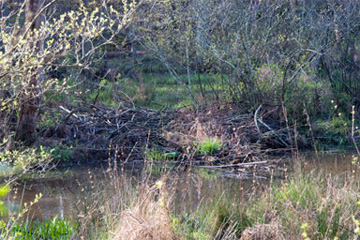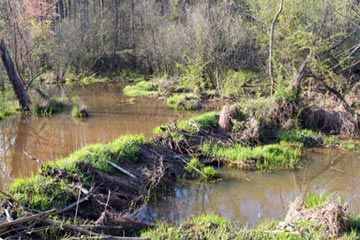Beaver Pond
  Beaver pond and dam along Tumbling Creek. |
 Beavers
(Castor canadensis) are thickset animals with paddle-shaped tails and hind legs
that are webbed for swimming. They use their tail for swimming and as a
rudder to steer. They are quite dexterous with their
forepaws and use them like hands. Beavers have anal oil glands that
produce a waterproofing oily solution that they smear on their fur. Their front teeth
or incisors are chisel-shaped enabling beavers to gnaw away
at trees and use their trunks and limbs to build dams and lodges. As is
the case with other rodents, their incisors continuously grow outward as
they are worn down by gnawing. Beavers can cut down a 12 cm (5")
diameter tree in about 30 minutes.
Beavers
(Castor canadensis) are thickset animals with paddle-shaped tails and hind legs
that are webbed for swimming. They use their tail for swimming and as a
rudder to steer. They are quite dexterous with their
forepaws and use them like hands. Beavers have anal oil glands that
produce a waterproofing oily solution that they smear on their fur. Their front teeth
or incisors are chisel-shaped enabling beavers to gnaw away
at trees and use their trunks and limbs to build dams and lodges. As is
the case with other rodents, their incisors continuously grow outward as
they are worn down by gnawing. Beavers can cut down a 12 cm (5")
diameter tree in about 30 minutes.
Beavers construct dams to slow down water to create ponds in order to maintain a steady depth of water. Water depth is important in order to (1) provide a place to store branches that supply bark for food, especially through the winter, and (2) provide for predator-resistant and ice-free underwater entrances to their homes. Beavers build lodges out of sticks, stones and mud that can be 2m (6 ft) and as much as 12m (40 ft) wide at their base under the water.
Beavers also build systems of interlacing canals within a flooded area in which to float branches back to their lodge. Beaver lodges often have several underwater entrances to discourage predation and the chamber inside (generally about 2m long and about 0.6m high) can be large enough to fit a grown man. Dams are often titled towards upstream towards the current as added reinforcement. Dams are regularly repaired.
Beavers are crepuscular (active at dawn and dusk). Beavers often work on their dams and lodges during the night. They are seldom seen during the day. Beavers eat all parts of a tree: leaves, buds, bark, roots, and the living layer beneath the bark called the cambium. Beavers also eat aquatic plants to include the roots. Beavers house microbes in the cecum of their intestines that allow them to digest cellulose which is unusual for mammals. During the fall, beavers make a deep hole in the water near their lodge and fill it with branches that they munch on through the winter. The cold water helps to keep the food fresh.
Beavers are territorial and will slap their tails against the water to create a loud noise to alert other beavers within their family of potential danger. Beavers are monogamous and mate in January or February. The female bears a litter of about 4 kits in April-May. The young typically live in the parental colony for two years (the age of sexual maturity) before they move on to mate and build their own lodge. Lodges generally house from 4-8 individuals to include the parents and two overlapping generations of the young. An area like Tumbling Creek could possibly support several colonies (beaver colony densities are usually about 0.4-0.8 colonies per square kilometer). Under good conditions, beavers can live for about 15-20 years in the wild. Beavers rarely go more than 200m from the water's edge.
Beavers are one of the few animals that significantly modify the environment in which they live. Beavers destroy habitat by flooding an area, but compensate for that by creating habitat for other animals and plants.
More information about beavers at Wikipedia.
